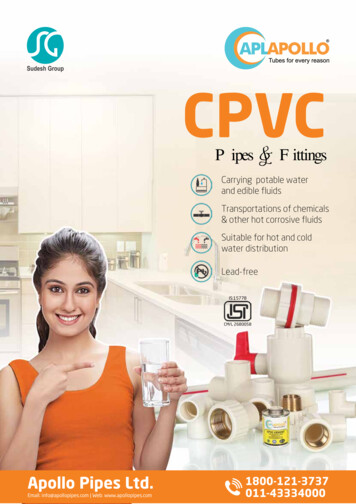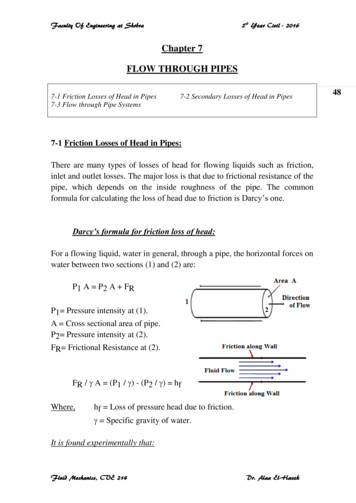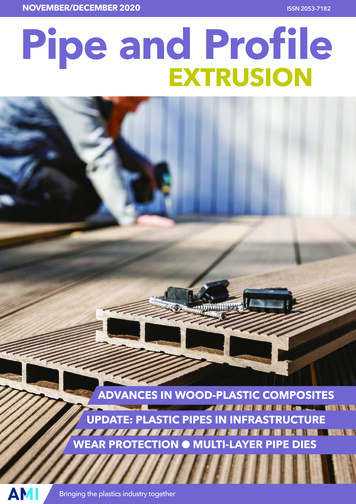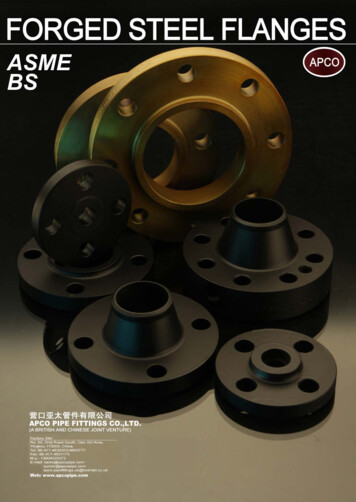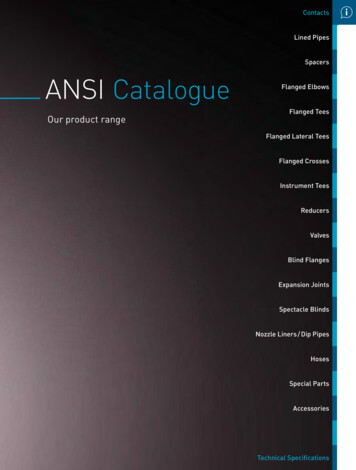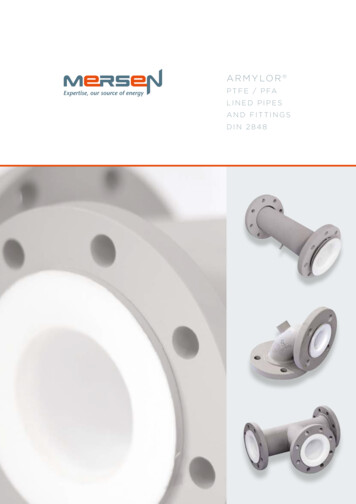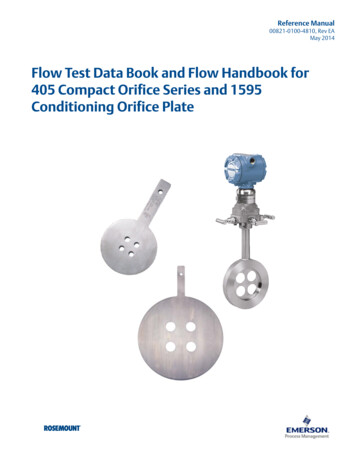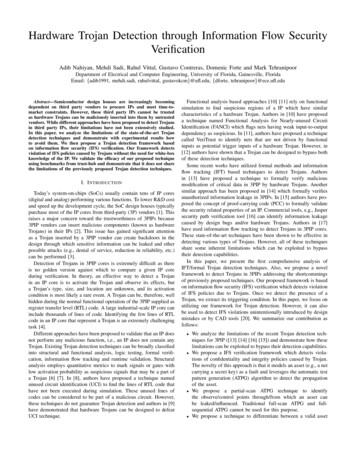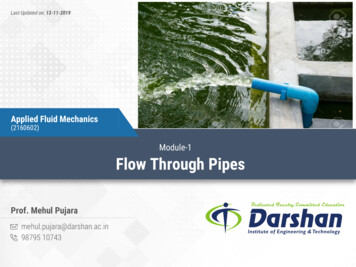
Transcription
Last Updated on: 13-11-2019Applied Fluid Mechanics(2160602)Module-1Flow Through PipesProf. Mehul Pujaramehul.pujara@darshan.ac.in98795 10743
SYLLABUSSr. ContentsNo.1 IntroductionContinuity equationEnergy equationMomentum equationMajor and minor energy losses,Hydraulic gradient and total energy linePipes in series and parallelPipe networksHydraulic transmission of powerNavier-Stokes equation of motionInitial conditions and boundary conditionsViscous flow-Couette flowHagen-Poiseuille equation-flow between parallel platesTurbulent flow in pipesPrandtl’s mixing length theoryVelocity distributionSmooth and rough boundariesWater hammer phenomenonModule-1 Flow Through Pipes2Teaching hoursWeightage%1230Darshan Institute of Engineering & Technology, Rajkot
GTU MIMP QEUSTIONS LISTSr. QuestionsNo.Exam Year Marks1Explain the terms: Hydraulic gradient line and Total energy line. OR Define:(i) Critical depth (ii) Total energy line (iii) Hydraulic gradient line.May-2019Nov-2017332Derive an expression for the loss of head due to sudden enlargement of apipe.May-2019Oct-2016May-20164773Prove that the velocity distribution for viscous flow between two parallelplates when both plates are fixed across a section is parabolic in nature.May-201974Explain the terms: Pipes in parallel and Equivalent pipe.35Derive an expression for the loss of head due to friction in pipe. OR Derive May-2019Darcy Weisbach formula for the loss of head due to friction in pipe line.Nov-2018Nov-2017Oct-201647776Enlist the major and minor loses in pipes. Derive the expression for loss of Nov-2018head due to sudden contraction. OR What are the minor losses? Under what April-2017circumstances will they be negligible? Derive the expression for loss ofhead due to sudden contraction.77Module-1 Flow Through Pipes3Darshan Institute of Engineering & Technology, Rajkot
GTU MIMP QEUSTIONS LISTSr. QuestionsNo.ExamYearMarks7Explain hydraulically smooth and rough pipesNov-2018Nov-2017338Calculate the head loss due to friction using Darcy Equation and powerrequired to maintain 60 liters per second of liquid flow through a steelpipe 0.08 m radius and 900 m long. Take Sp. Gravity of the liquid 0.85 and co-efficient of friction f 0.0025.Nov-201879Enlist the important applications of Navier-stoke equationsNov-2018April-20174310Define (i) Cavitation (ii) Prandtl Mixing length (iii) Water Hammer ORDescribe water hammer phenomenon in pipes. OR Explain brieflyPrandtl’s mixing layer theory.OR (i) Shear VelocityNov-2018Nov-2017April-201733311Explain Hagen-Poiseuille theory. OR Derive the Hagen-Poiseuilleequation and state the assumptions made. OR Derive an expression forthe velocity distribution of viscous flow through a circular pipe andprove that the ratio of maximum velocity to average velocity is 7Module-1 Flow Through Pipes4Darshan Institute of Engineering & Technology, Rajkot
GTU MIMP QEUSTIONS LISTSr. QuestionsNo.Exam Year Marks12Describe relation between shear stress and velocity gradient.13What is couette flow? Derive an expression of velocity and shear stressfor couette flow.714Explain different types of shear theories for turbulent flow.315Write advantages and disadvantages of shear theories.416A rough pipe of 30 cm diameter carries water. If the mean pointvelocity and the velocity gradient at a distance of 3 cm from pipe wallare 2 m/sec and 12.5 sec-1 respectively, determine the average heightof roughness projection, wall shear stress, friction factor and meanvelocity of flow. Take ρ 1000 kg/m3 and κ(kappa) 0.4717What do you mean by pipes in series and pipes in parallel? How theloss of head is determined in both systems318Write a brief note on major and minor losses in pipes.Module-1 Flow Through Pipes5April-2018Nov-201744Darshan Institute of Engineering & Technology, Rajkot
GTU MIMP QEUSTIONS LISTSr. QuestionsNo.19Exam Year MarksA pipe system consists of three pipes arranged in series.Nov-20177April-20173Transform the system to (i) an equivalent length of 30 cm diameterpipe, and (ii) an equivalent diameter for the pipe 6500 m long.20Write the assumptions made in derivation of the Dynamic Equation ofthe Gradually varied flow.21What are the differences between pipe flow and open channel flow?Also write the uses of pipes for hydraulic transmission of fluid.422Derive the continuity equation for one dimensional flow and discuss itsapplication.723Enlist the forces acting on Fluid in motion.4Module-1 Flow Through Pipes6Darshan Institute of Engineering & Technology, Rajkot
GTU MIMP QEUSTIONS LISTSr. QuestionsNo.Exam Year Marks24Calculate the head loss due to friction using Darcy Equation and powerrequired to maintain 50.3 liters per second of liquid flow through asteel pipe 0.1 m radius and 900 m long. Take Sp. Gravity of the liquid 0.7 and co-efficient of friction f 0.0025.April-2017725A horizontal pipe of 150 mm diameter is suddenly enlarged to 300 mmdiameter. The rate of flow of water through a pipe is 0.2 m3/sec. Thepressure intensity of smaller pipe 125 kPa. Determine (i) Loss of headdue to sudden enlargement (ii) Pressure intensity in large pipe.Oct-2016726A pipe of diameter of 20 cm conveying water. Calculate the dischargewhen centre line velocity is 3 m/sec and velocity at a point 4 cm fromcentre is 2.5 m/sec.727A smooth pipe of diameter 400 mm and length 800 m carries water at May-2016a rate of 0.40 m3/s. determine the head lost due to friction, wall shearstress, centre line velocity and thickness of laminar sub-layer. Takekinematic viscosity of water as 0.018 stokes and coefficient of friction,f 0.0791/ (Re)1/47Module-1 Flow Through Pipes7Darshan Institute of Engineering & Technology, Rajkot
GTU MIMP QEUSTIONS LISTSr. QuestionsNo.28Exam Year MarksTwo reservoirs are connected by two pipes in series of lengths 200 mand 300 m and of diameters 20 cm and 30 cm respectively. Thedifference of head between the two reservoir water surfaces is 10m.The friction factors for the two pipes are 0.02 and 0.015 respectively.Determine the flow rate.May-20167ALL THE BESTModule-1 Flow Through Pipes8Darshan Institute of Engineering & Technology, Rajkot
Fluid: The term fluid refers to both aliquid and a gas; it is generallydefined as a state of matter inwhich the material flows freelyunder the action of a shearstress.Module-1 Flow Through Pipes9Darshan Institute of Engineering & Technology, Rajkot
Fluid Kinematics? A branch of fluid mechanics whichdeals with the study of velocity andacceleration of the particles offluids in motion and theirdistribution in space withoutconsidering any forces or energyinvolved. It provides(i) an idea about the rate offlow(II) an idea about differenttypes of velocities of flow Equation of Continuity is the first and fundamental equation of flow.Module-1 Flow Through Pipes10Darshan Institute of Engineering & Technology, Rajkot
Rate of Flow:1. Mass flow rate (𝑚)2. Volume flow rate(𝑄)Module-1 Flow Through Pipes11Darshan Institute of Engineering & Technology, Rajkot
Volume Flow Rate:Module-1 Flow Through Pipes12Darshan Institute of Engineering & Technology, Rajkot
Mass Flow Rate:Module-1 Flow Through Pipes13Darshan Institute of Engineering & Technology, Rajkot
Control Volume Approach: A system is whatever the engineer selects forstudy. Open System (Control Volume system) Closed System (Control Mass system) The control volume involves selection and analysisof a region in space, the CV is an Eulerian concept. The closed system involves selection and analysisof a specific collection of matter, the closedsystem is a Lagrangian concept.Module-1 Flow Through Pipes14Darshan Institute of Engineering & Technology, Rajkot
Langrangian Concept: Observer concentrates on themovement of single particle.PP Observer has to move with thefluid particle to observe itsmovementPP The path and changes in velocity,acceleration, pressure and densityof a single particle are described. Not commonly use. 𝑥𝑢 𝑡 𝑦𝑣 𝑡 𝑧𝑤 𝑡 2𝑥𝑎𝑥 𝑡 2 2𝑦𝑎𝑦 𝑡 2 2𝑧𝑎𝑧 𝑡 2Module-1 Flow Through Pipes15Darshan Institute of Engineering & Technology, Rajkot
Eulerian Concept: Observer concentrates on variousfixed point particles. Observer remains steady andobserve the change in the fluidparameters at the fixed point only Method describes the overall flowcharacteristics at various points asfluid particle pass. Commonly used.u f1 (x,y,z,t), v f2(x,y,z,t), W f3(x,y,z,t)Module-1 Flow Through Pipes16Darshan Institute of Engineering & Technology, Rajkot
Lines of flow to describe the motion of the fluid:1. Path line2. Stream line3. Stream tube4. Streak line or filament line5. Potential lineModule-1 Flow Through Pipes17Darshan Institute of Engineering & Technology, Rajkot
Path line: The path traced by single fluid particle inmotion over a period of time is called itspath line. The path line shows the direction ofvelocity of the particle as it moves ahead. During steady flow, path line coincide withstream line. However path line fluctuates betweendifferent stream lines during an unsteadyflow. It is real line showing successive position ofone particle. Particle may cross its path line.Module-1 Flow Through Pipes18Darshan Institute of Engineering & Technology, Rajkot
Stream line: A stream line is imaginary line drawnthrough a flowing fluid such that the tangentat each point on the line indicates thedirection of the velocity of the fluid particleat that point. It shows positions of various fluid particles. Stream line can not intersect each other,they are always parallel. No flow across stream line.Module-1 Flow Through Pipes19Darshan Institute of Engineering & Technology, Rajkot
Stream Tube: A circular space formed by the collection ofstream lines passing through the perimeterof a closed curve in a steady flow. Stream tube behaves as a solid surfacetube. It may be of regular or irregular shape.Module-1 Flow Through Pipes20Darshan Institute of Engineering & Technology, Rajkot
Streak line or Filament line: Real line showing an instantaneouspicture of the position of all fluidparticles in the flow which havepassed from a given point. The line of smoke from chimney isnothing but a streak line. It may change instant to instant. Flow across streak line is possible.Module-1 Flow Through Pipes21Darshan Institute of Engineering & Technology, Rajkot
Potential Line: The lines of equal velocity potential arecalled potential line. Stream line and potential line are at rightangle to each other.Module-1 Flow Through Pipes22Darshan Institute of Engineering & Technology, Rajkot
Types of fluid flow: Steady or Unsteady Uniform or Non-uniform Laminar or Turbulent Compressible or Incompressible Rotational or Irrotational One, Two or Three DimensionalModule-1 Flow Through Pipes23Darshan Institute of Engineering & Technology, Rajkot
Steady vs. Unsteady Flow: Fluid characteristics like velocity,acceleration, pressure and densitydo not change with time at anypoint in the fluid is called steadyflow. 𝑣 𝑃 𝜌 2 𝑣 0, 0, 0 , 2 0 𝑡 𝑡 𝑡 𝑡 Flow of water with constantdischarge through pipeline. If fluid properties changes with timeits called unsteady flow.Module-1 Flow Through Pipes24Darshan Institute of Engineering & Technology, Rajkot
Uniform vs. Non-uniform flow: Velocity of the flow does not changealong its direction of flow at any point oftime is called Uniform flow. Flow through a constant diameter pipeline is uniform flow. 𝑣 𝑠 0 Velocity of flow changes with its directionof flow any instant of time is called Nonuniform flow.Module-1 Flow Through Pipes25Darshan Institute of Engineering & Technology, Rajkot
Laminar vs. Turbulent Flow: Fluid particles move in layers witheach layer sliding over the other, theflow is called laminar Flow. Velocity of flow is very small. Reynolds number 2100 The flow in which adjacent layerscross each other and the layers donot move along the well definedpath is called turbulent Flow. Reynolds number 4000Module-1 Flow Through Pipes26Darshan Institute of Engineering & Technology, Rajkot
Compressible vs. Incompressible Flow: The volume and hence density of thefluid does not remain constant duringthe flow is called compressible flow. Gases are compressible. The flow in which the changes involume and thereby density of the fluidare insignificant, the flow isincompressible. Liquids are incompressible. For gases in subsonic aerodynamiccondition air flow can be considerincompressible.Module-1 Flow Through Pipes27Darshan Institute of Engineering & Technology, Rajkot
Rotational vs. Irrotational Flow: Fluid particles rotate about their own axiswhile flowing along stream lines, is calledrotational flow.Ex. Motion of a liquid in a rotating cylinder is arotational flow. The flow in which fluid particles do notrotate about their own axis while flowingalong stream lines is called Irrotationalflow. Flow of water in emptying wash basing isIrrotational flow.Module-1 Flow Through Pipes28Darshan Institute of Engineering & Technology, Rajkot
One, Two and Three Dimensional Flows: Flow parameter such as velocity is afunction of time and one space coordinate only, say x is called OneDimensional flow.Ex. Ex. u f(x), v 0 and w 0 Flow parameter such as velocity is afunction of time and two space coordinate only, say x and y is called TwoDimensional flow.Ex. Ex. u f1(x,y), v f2(x,y) and w 0 Flow parameter such as velocity is afunction of time and three space coordinate only, say x,y and z is calledThree Dimensional flow.Ex. Ex. u f1(x,y,z), v f2(x,y,z) and w f3(x,y,z)Module-1 Flow Through Pipes29Darshan Institute of Engineering & Technology, Rajkot
Critical Depth: Critical depth (yc) is defined as the depth of flow where energy is at aminimum for a particular discharge. For a given value of specific energy, the critical depth gives the greatestdischarge, or conversely, for a given discharge, the specific energy is aminimum for the criti
Velocity distribution Smooth and rough boundaries Water hammer phenomenon 12 30 SYLLABUS. Module-1 Flow Through Pipes 3 Darshan Institute of Engineering & Technology, Rajkot Sr. No. Questions Exam Year Marks 1 Explain the terms: Hydraulic gradient line and Total energy line. OR Define: (i) Critical depth (ii) Total energy line (iii) Hydraulic gradient line. May-2019 Nov-2017 3 3 2 .
